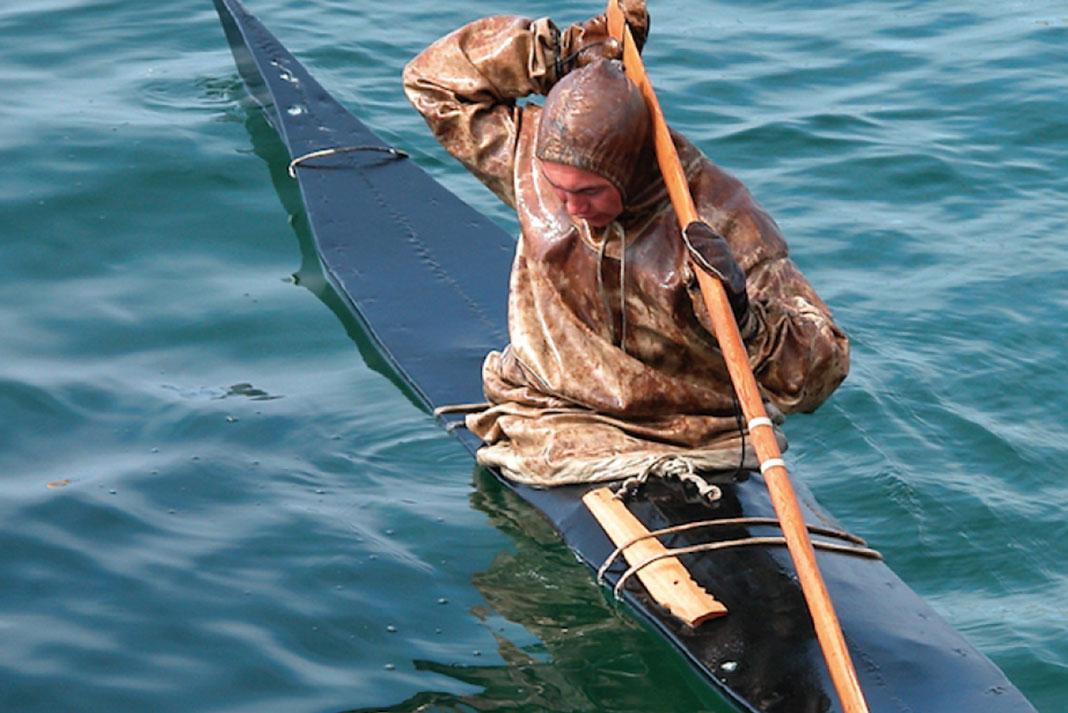The origins of Greenland-style paddling are lost in the folds of oral history, sepia-toned photographs and the minds of modern-day theorists, but the renaissance of modern Greenland kayaking is as tangible as the thousands of toothpick-wielding paddlers churning north American waters today.
Greenland-style kayaking has grown remarkably in recent years. Every major kayak symposium now includes a Greenland rolling demonstration or paddling workshop. This February, Florida’s Sweetwater Kayaks organized its first Greenland-only symposium, while Qajaq USA’s training camp, held in Michigan every August since 2002, puts names on a waiting list a month in advance.
Greenland-style is time-tested
A Texan is responsible for popularizing Greenland-style paddling in North America. John Heath began his mission to reaffirm the design attributes of traditional Arctic kayaks in the 1950s. He travelled from Siberia to Greenland, interviewing the last kayak-hunters and measuring their boats. Until he passed away in 2003, Heath argued for the merits of the Inuit designs, figuring that in a time when the price of poor kayak performance was drowning or starvation, the boats had to be well thought-out.
The launch of modern Greenland kayaking
In 1998, Heath brought Maligiaq Padilla, a 16-year-old Greenland national kayaking champion, to the United States for a year-long circuit of symposiums. For Mark Molina, an American paddler who has competed twice and won multiple gold medals in the Greenland National Kayaking Championships, it was Padilla’s demonstrations of traditional paddling techniques that kindled the Greenland-style renaissance.
“I never liked anything about kayaking until I saw what Maligiaq could do,” Molina says.
Padilla’s visit brought what was then a small but dedicated community of Greenland-style paddlers into the mainstream.

Greg Stamer, who began using a Greenland paddle in the early 1990s, founded Qajaq USA, the American chapter of the Greenland Kayaking Association, shortly thereafter. And in the Great Lakes, veteran skinny-bladed roller Doug Van Doren’s demonstrations became less of a symposium freak show and more of an inspiration for other modern Greenland-style kayakers.
“I never liked anything about kayaking until I saw what Maligiaq could do.”
Industry jumps on board
Sea kayak manufacturers have climbed on board, flooding the market with “Greenland-style” boats. British manufacturers—who’ve claimed to be riding the Greenland wave all along—saw a spike in sales of classic models like Valley Canoe Products’ Anas Acuta and up-start designs like Nigel Dennis’ Greenlander. In North America, modern Greenland kayaks include the Caribou by Current Designs, the Ellesmere by Boréal Design, and a composite version of Jay Babina’s Outer Island design produced by Impex.
Even as skin-on-frame boats and wooden Greenland paddles get made over in contemporary materials, modern Greenland kayaking remains compelling as an antidote to carbon fiber, Kevlar and polymer plastic. The sport is cheap and easy to pick up. A Greenland-style paddle costs 20 bucks and a weekend of labour; a new boat, $500 and a couple weeks in the shop. Traditional paddling techniques can be developed over the course of a summer on the water or a winter in the pool.
Perhaps the greatest attraction of the Greenland style is that its vast repertoire of braces and rolls promises kayakers complete mastery of their medium.
Greenland-style kayaking has undeniable appeal
The neophyte—like Mark Molina watching Maligiaq Padilla for the first time in 1998—sees the Greenland-style guru perform an oxygen-defying dance along the edge of danger, rolling in contorted poses with and without a paddle. It has the snake-charmer’s appeal of taking every beginning kayaker’s biggest fear—flipping over—and literally turning it on its head.
Who wouldn’t be captivated by the possibilities of modern Greenland kayaking?


